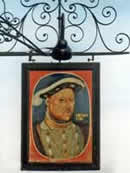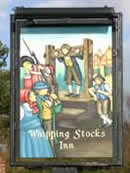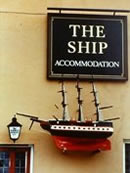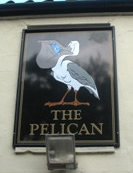Sign Language
Along their roads the Romans constructed 'tabernae' – taverns – originally shops that mainly sold wine, where travellers could obtain food and overnight lodging. They decreed all taverns be identifiable by branches of evergreens fixed to the outside of the building. This symbolised Bacchus, the Greek god of wine, and eventually gave rise to one of the earliest pub names – The Bush.
Behind the present-day, idyllic image of the English country pub lie centuries of tradition going back to medieval times. The well-to-do would usually stay in local manor houses or perhaps castles, but commoners, who rarely left their home village, slept where they could in barns or under hedgerows. Then, an inn was a place offering ordinary travellers shelter for the night plus something to eat and drink, and many were established by hospitable monks who first set up hospices or hostels.
The George & Pilgrims (Glastonbury) and The Angel (Guildford) are inns that began in this way.
In 1393 King Richard II decreed that pubs must have signs "Whoever shall brew ale in the town for the intention of selling it, must hang out a sign, otherwise he shall forfeit his ale."
Following the Dissolution of the Monasteries in 1538, many hospices became inns run by lay brothers, who were the first innkeepers. Before Henry VIII ordered the breakaway from Rome, The Popes Head (now extinct) was a common name. To stay on the right side of the king, astute innkeepers quickly changed the name to The Kings Head (ubiquitous) which explains why the Tudor monarch’s face is to be seen still on so many pub signs today. Henry’s daughter, Elizabeth, by his second wife Anne Boleyn is much in evidence on signs of The Queens Head.
As villages grew, the function of the inn changed. It became a social centre for the community as well as a lodging place for travellers. Despite rutted roads and the constant threat posed by highwaymen, the comparative luxury of the stage coach provided speedier travel for those able to afford the fare. Many inns, particularly in towns, became coaching inns. The Coach & Horses is a popular, present-day reminder.
Today, many such inns are recognisable by a large archway leading to a rear courtyard. As coaching days were numbered and gave way to railways, we now have signs such as The Railway or The Station throughout the land.
Following the rise of the public house, or 'Pub', modern signs cover a huge range of subjects; e.g Famous people and places, local stories and interest, many humorous, cartoon, or fashionably stylised.

The Kings Head
Warwick, Warwickshire

Whipping Stocks Inn
Over Peover, Cheshire

The Ship
Brancaster, Norfolk

The Pelican
Tacolneston, Norfolk
Types of Signs & Frames
For many observers, the image on the inn sign is what catches the eye and holds the interest. If you do not share that view, pause next time you pass a sign on your way into the pub. But take a new look at the whole sign. You might be surprised by the amount of detail that is included.
In times past, most signs were hand-painted and made of wood or metal. Today, signs are increasingly being produced by computer-generated graphics on lightweight materials such as aluminium, fibreglass, perspex or similar. Other materials used for pub signs include sandstone, stained glass.
The Glassworks in Stourbridge had such a glass sign, which survived intact for a number of years. In Grantham, Lincolnshire, the Beehive had a living sign that is positively buzzing. Three-dimensional (3D) signs like The Ship at Brancaster, Norfolk provide another source of interest. Most signs are either portrait or landscape-orientated. Circular signs are to be seen, mostly in the East Midlands.
Styles of Sign
|
|
| - |
Hanging signs are normally fixed to the building, hang from a bracket and have no visible means of support from below. |
| - |
Pillory signs are freestanding and often situated away from the pub – perhaps in the car park. |
| - |
Banged-up is a term coined for signs that are fitted or mounted directly on to the wall of the pub building. |
| - |
Pinioned signs are free-standing and supported by two stout posts or columns on either side. Often, such signs are made of a plastic-type material and contain internal lighting. |
| - |
Gallows, or beam signs, stretched the width of the road or pavement. Many signs that once spanned the highway have been removed due to the increased size of vehicles. |
| - |
3-D signs are still quite popular and can be seen in all preceding variety of fixings. |
|
Types of Frames
Like any painting, sketch or illustration, the image may be enhanced by the choice of decorative frame.
Not all subjects are suitable for intricate wrought-iron work. Many such frames were made by the local blacksmith.
Modern frames tend to be made of wood or metal. Most are plain, utilitarian and functional, and are not particularly attractive.